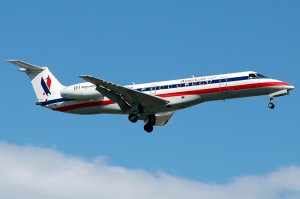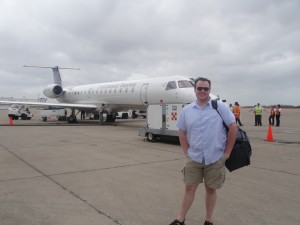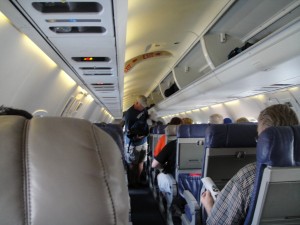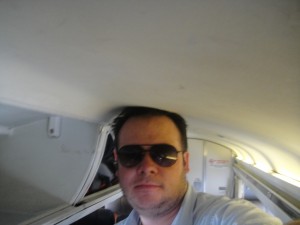
An American Eagle ERJ-135
First off, let me say that being an airline pilot is not an easy job. It is very complex, a lot can go wrong and regional pilots are not paid to the level of their talent. However, a few bad apples can make pilots seem unprofessional, which is far from the truth.
That said, none of them should be making such a careless mistake. They go through a lot of training to prepare to handle a difficult situation and more importantly, make sure things don’t go wrong. Each time they fly they hold many lives in their hands.
The Wall Street Journal highlighted two recent incidents of pilots on commuter airlines forgetting to start their second engine during take off. No one was hurt and the takeoffs were successfully aborted, but forgetting to have your engines turned on it is a huge oversight.
Airlines usually use one engine during taxi to conserve on fuel. However, written and verbal checklists (not to mention common sense) ensures that pilots are prepared for takeoff (ie using both engines).
In one case, a pilot for an American Eagle regional jet was flying from Los Angeles to San Diego. He got distracted talking to the control tower and assumed he started the second engine. When trying to take off, he received an automated warning showing the second engine wasn’t to speed and they headed back to the gate. They thought the engine was malfunctioning until mechanics found it was never started (now that’s embarrassing).
American Eagle states the pilots went though additional training and updated their takeoff checklist. Really? I am not quite sure how the updated checklist would help. “Before take off, be sure both engines are running. We REALLY mean it, double check. Did you check? For both? Ready for takeoff? Actually just check one more time to be sure.”
The second incident happened with another regional jet flying for Trans States Airlines (which flies for United and US Airways) at Dulles International Airport. Again the pilot didn’t realize his second engine wasn’t started until they were lined up for takeoff and at full throttle.
Wanting an inside perspective I spoke with a regional jet pilot (who wanted to remain anonymous). She told me, “It’s sad that airlines, in general, are still experiencing a lack of safety issues. We should be more paranoid now than ever before about checklists and procedures. To miss something so crucial is unacceptable. Not all pilots are like this but without a serious change in the industry (ie supporting pilots) stupid mistakes will continue to occur. For the most part, pilots are very safety conscious and overly cautious of everything.”
These recent incidents have raised questions (once again) about commuter carriers. Many people say they are over worked and under paid. But regional jets provide airlines a lower overhead and provide you, the customer, a cheaper ticket.
I don’t know about you, but I am more than willing to pay a few bucks more to make sure airlines hire and keep highly trained and motivated pilots that do not need to be abused to earn their seniority.
Image: caribb
connect | web | twitter | facebook |

Me in front of the first ERJ-145 I flew after landing at Mazatlan Airport. I love being able to get close to the plane on the tarmac.
I am currently about 37,000 feet on a Continental Express ERJ-145. I am heading from Mazatlan, Mexico (MZT) to Houston, TX (IAH), then on to my home in Seattle (SEA) [which will be on a Boeing 757]. Well, sort of…right now, as I write this blog, it is the morning of Saturday May 8th. My flight does not have wi-fi, but I am writing it in notepad and will post it up on Monday the 10th. Every time I am in the air, I always try to write up at least a few blogs, since I love the inspiration.
This is my second flight in a regional jet, my first being a week ago heading from IAH to MZT. It is quite amazing, with all my flying experience I have not flown on a ERJ-145. My home base is in Seattle and there just aren’t many flights with regional jets to and from SEA.
When booking my flight, I purposely choose Continental since I would be able to fly on an ERJ-145 (I know, I have heard the “airline nerd” jokes already). I have heard some positive, but mostly negative things about flying the aircraft and I was excited to check it out myself.

The 1-2 layout is nice, but small overhead-bins are only on one side.
There are a lot of people out there that do not like flying in smaller planes. They will go out of their way and pay more to avoid them. Yes, the ride can be more bumpy, there are normally less experienced pilots flying them, and it can be a tight fit. However, I think the positives out weigh the negatives.
For me, the smaller the aircraft let me feel more connected to the flying experience. I understand that some people like to forget they are in a man-made machine 37,000 feet above the ground, but not me.
I enjoy the 1-2 seat layout. There is a single seat on the left side of the plane and two seats on the right side of the plane. This means that every person either has a window or aisle seat. On both flights I sat on the single seat side. It is nice being able to see out the window and have easy access to the aisle.
The seats feel quite roomy and the ERJ-145 has 17.3″ width and 31″ pitch, which isn’t bad. The Boeing 737-800 I flew from SEA to IAH also had 31″ pitch and only 17.2″ width.

Don't make fun of my hecka-awesome shades or my man-beard. Headroom wasn't so great for being 6'1".
The ERJ-145 only holds 50 passengers, which gives it an intimate experience. I seems easier to talk to other passengers and get to know those around me. Since there are less passengers, the turn around time of the aircraft is very short (time from landing to being able to take off again). This allows airlines to provide more flight options to destinations and more flights to smaller airports.
There are a few downsides to the ERJ-145. I am currently sitting in row 17 of 19 rows. The only lavatory is located at the back of the aircraft. It seems not many people went to the restroom before taking off, since a lot of folks have made a visit back here. I could see where this would be distracting for someone wanting to sleep.
There is also very limited carry-on room. If you are trying to bring on bigger carry-ons, be prepared to have them checked. Out of the five of us travelling in my group, only two were able to bring their carry-ons aboard (and we were able to take all of them on board the Boeing 737 from SEA to IAH).
I have heard people talk about service on smaller regional aircraft can be sub-par. Even though I have experienced great service on some smaller airlines, like Horizon Air (the free beer or wine helps), I have personally seen a lower level of service when flying regional aircraft. Although I did get a free snack (this will be short lived), the flight attendants, both to and from MZT, definitely were not friendly and were quite rude to passengers. It could have just been a coincidence, but it was noticeable.
My flights to and from MZT were Continental Express, which is run by ExpressJet, however, the Continental name is on the airplane and on my ticket. I strongly feel that is a larger airline is willing to put their name on a regional airline, they are partly responsible for the quality of service one receives. Passengers should have a consistent level of service no matter what kind of aircraft they are flying.
The ERJ-145 is built by Embraer, an airplane manufacture based out of Brazil. The aircraft first flew in August 1995 and started service with airlines in 1996. To date over 1,100 ERJ’s have been manufactured. With so many ERJ-145’s out there and many more on order, I have a feeling this won’t be my last experience with this aircraft type.
Find a few more pics via my Flickr account.
connect | web | twitter | facebook |



